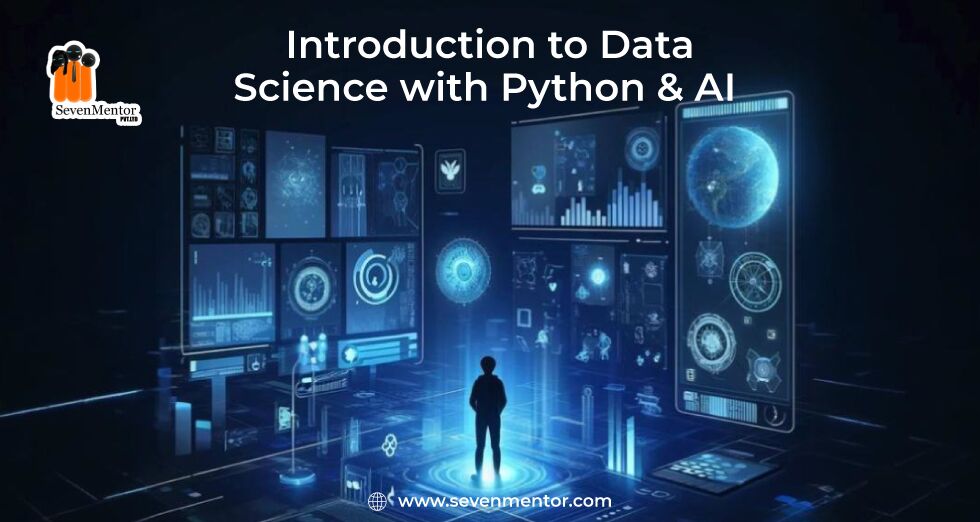Introduction to Data Science with Python and AI
Data Science and Artificial Intelligence (AI) are transforming the world, enabling businesses and individuals to make smarter decisions. Python, with its simplicity and powerful libraries, has become the go-to language for Data Science and AI. This blog explores how the upcoming generation can leverage Python for Data Science and AI, key libraries, and future applications. Discover the Introduction to Data Science with Python and AI, covering data analysis, machine learning, and AI techniques to boost your skills in 2025.
Why Python for Data Science and AI?
Python’s popularity in Data Science and AI is driven by:
- Ease of Learning – Python’s simple syntax makes it beginner-friendly.
- Rich Ecosystem – A vast collection of libraries supports AI, machine learning, and data analysis.
- Scalability – Python allows seamless development from small-scale projects to enterprise-level applications.
- Integration with AI Frameworks – Python integrates with AI platforms, making it the best choice for modern applications.
Essential Python Libraries for Data Science and AI
Python offers numerous libraries for Data Science and AI:
- NumPy – Supports numerical computing.
- Pandas – Facilitates data manipulation and analysis.
- Matplotlib & Seaborn – Used for data visualization.
- Scikit-learn – Provides machine learning algorithms.
- TensorFlow & PyTorch – Powers deep learning and AI applications.
- OpenCV – Supports computer vision.
- NLTK & SpaCy – Used for natural language processing (NLP).
Step-by-Step Guide to Data Science and AI with Python
1. Data Collection and Preprocessing
The first step in AI-driven Data Science is collecting and cleaning data.
import pandas as pd
import numpy as np
data = pd.read_csv(“data.csv”)
data.fillna(method=’ffill’, inplace=True) # Handling missing values
2. Exploratory Data Analysis (EDA)
EDA helps understand data distributions and insights.
import seaborn as sns
import matplotlib.pyplot as plt
sns.histplot(data[‘column_name’])
plt.show()
3. Feature Engineering and Selection
Creating new features improves model performance
data[‘new_feature’] = data[‘feature1’] * data[‘feature2’]
.4. Machine Learning Model Building
Using Scikit-learn for AI-driven predictions
from sklearn.model_selection import train_test_split
from sklearn.ensemble import RandomForestClassifier
X = data.drop(‘target’, axis=1)
y = data[‘target’]
X_train, X_test, y_train, y_test = train_test_split(X, y, test_size=0.2, random_state=42)
model = RandomForestClassifier()
model.fit(X_train, y_train)
.5. Deep Learning with Python
Using TensorFlow for neural networks.
import tensorflow as tf
from tensorflow import keras
model = keras.Sequential([
keras.layers.Dense(128, activation=’relu’),
keras.layers.Dense(64, activation=’relu’),
keras.layers.Dense(1, activation=’sigmoid’)
])
model.compile(optimizer=’adam’, loss=’binary_crossentropy’, metrics=[‘accuracy’])
6. AI-Powered Natural Language Processing (NLP)
Using SpaCy for text processing.
import spacy
nlp = spacy.load(“en_core_web_sm”)
doc = nlp(“AI is transforming the world”)
print([token.text for token in doc])
7. AI in Computer Vision
Using OpenCV for image recognition
import cv2
image = cv2.imread(“image.jpg”)
gray_image = cv2.cvtColor(image, cv2.COLOR_BGR2GRAY)
cv2.imshow(“Gray Image”, gray_image)
cv2.waitKey(0)
cv2.destroyAllWindows()
8. Deployment of AI Models
Using Flask for AI model deployment.
from flask import Flask, request, jsonify
app = Flask(__name__)
@app.route(‘/predict’, methods=[‘POST’])
def predict():
data = request.get_json()
prediction = model.predict([data[‘features’]])
return jsonify({‘prediction’: prediction.tolist()})
if __name__ == ‘__main__’:
app.run(debug=True)
Future of Data Science and AI for the Next Generation
- AI in Healthcare – Predicting diseases, AI-driven diagnostics, and robotic surgeries.
- AI in Finance – Fraud detection, stock market predictions, and automated trading.
- AI in Education – Personalized learning experiences and AI tutors.
- AI in Smart Cities – Traffic control, energy management, and security systems.
- AI in Robotics – Autonomous vehicles, industrial automation, and AI-powered assistants.
The upcoming generation has immense opportunities in Data Science and AI. Python remains the key to unlocking these advancements. From traditional data analysis to AI-powered automation, Python makes it accessible for students, professionals, and businesses. Embracing AI-driven Data Science will pave the way for innovations across industries.
Do visit our channel to learn More: Click Here
Author:-
Shivsharan Kunchalwar
Call the Trainer and Book your free demo Class for Data Science Call now!!!
| SevenMentor Pvt Ltd.
© Copyright 2025 | SevenMentor Pvt Ltd
